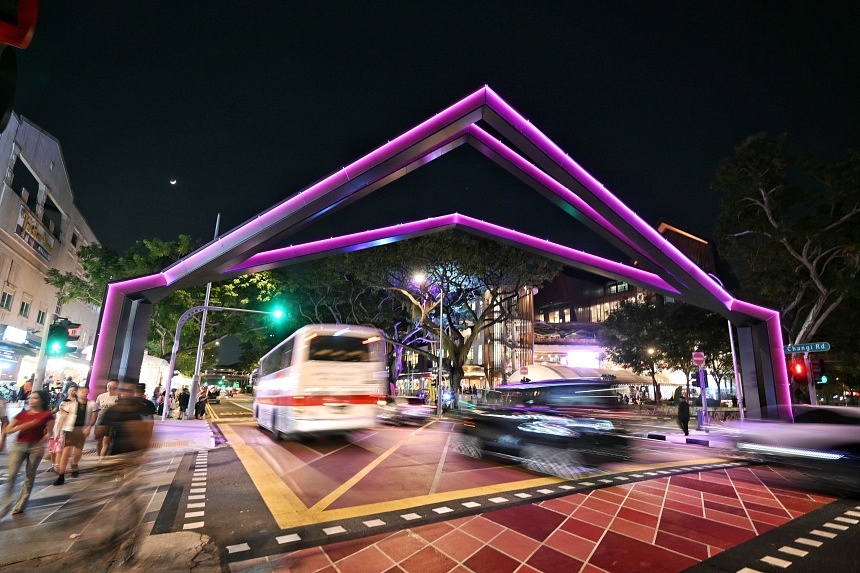SINGAPORE - The rejuvenation works for the Geylang Serai cultural belt has been completed, with an arch that stretches across the junction of Geylang Road and Joo Chiat Road being the landmark of the area.
The arch, which is designed after Malay kampung houses, is located at the corner of Geylang Serai Market and Hotel 81 Tristar.
Road paintings inspired by traditional weaving craft at the junction and a new shared path for pedestrians and cyclists at the Geylang Serai Market are among other rejuvenation efforts in the cultural belt.
At Joo Chiat Complex shopping mall, improvements include a new glass entrance canopy, a playground and bicycle parking spaces, as well as an upgraded drop-off point and pathway.
Prime Minister Lawrence Wong, who was guest of honour at the launch of the arch on Sept 7, said Geylang Serai has become a well-integrated community that reflects Singapore’s multiracial and multi-religious society.
“The Government is fully committed to ensuring that Geylang Serai will continue to have the best of the new and the old – a vibrant place with modern amenities, and also one that retains its distinctive Malay heritage,” he added.
Minister in the Prime Minister’s Office Maliki Osman, who chairs the steering committee for the Geylang Serai Cultural Precinct, said the arch – which stretches across a cross junction – is the first of its kind in Singapore.
“We also used night lighting to bring out the unique features of the iconic arch, which we hope will attract a lot more people to come in the evenings,” he said.
Dr Maliki added that the idea for the development of the cultural belt stemmed from consulting more than 10,000 stakeholders, including residents, through community engagement sessions in 2019.
“With the upgraded communal spaces, there will be more efforts to showcase the rich Malay heritage for others to appreciate,” he said.

Mr Osman Sudin, chairman of the Pasar Geylang Serai Merchants’ Association, said he hopes that footfall to the area will improve when Geylang Serai Market opens on Nov 1.
The closure of the market in August for renovation means that the 365 stallholders will have to shutter for another eight weeks.
“The stallholders are facing some difficulties as they have no income for the time being, but I believe we need to sacrifice this period to improve the market,” said Mr Osman, who owns a grilled chicken rice stall in the market.
At Joo Chiat Complex, business owner Haja Alauddin said he hoped the upgraded amenities, such as the drop-off point and playground, would attract more customers to the area as business had been tough since the Covid-19 pandemic.
The 50-year-old said business at his shoe shop, Aysa Store, had plunged 50 per cent since 2020, especially when construction in the area began in 2023.
“I’ve been struggling to cover rent and the salaries of my three staff. Some evenings, there may be no customers at all,” he said, adding that most of his customers were patrons of Geylang Serai Market.
“With the market closed until November, I can only hope the new drop-off point which opened last week can attract more customers.”
The owner of cosmetics store, Himoodra Original, who wanted to be known only as Madam Rahimah, 60, said the complex was like a “ghost town” while undergoing construction.
“Outside of the Ramadan festivities, I can count the number of customers I get in a day on one hand,” she said.

Mr Wong said the authorities are not yet done with improvement works for Geylang Serai.
“To the east and west, there are still many possibilities for us to make this cultural belt come alive – not just as a modern and vibrant neighbourhood but one that keeps Malay heritage and culture alive,” he added.
In a media doorstop, Dr Maliki said the second phase of rejuvenation will look at Tanjong Katong Complex, and more details will be announced in the coming weeks.
“It is another iconic building, and the feedback we received was to keep the basic infrastructure in place even if we need to redevelop it,” he said.


